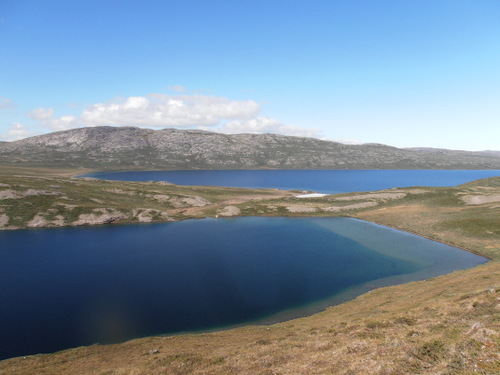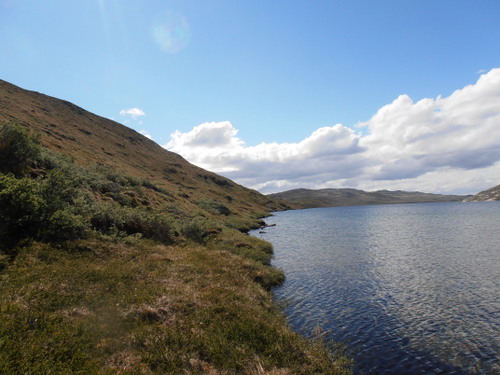Yesterday was my first Fourth of July in Greenland. Actually, it was my first Fourth of July ever, and truthfully, I don’t think I would have been more elated to spend it on any other ice sheet, or country for that matter. Besides the makeshift grills and after dinner games, the highlight of the day was the most epic hiking adventure I could ever imagine.
First of all let’s consider the cultural make-up of our group. We had two Danes, Josephine and Thomas, both porcelain-pale and eager for adventure. The beautiful Samantha from New Mexico, the fishing-hat-wearing Sam from Massachusetts, and me, Chloe, the eager beaver from Minnesota. By this time in the trip we’ve established a strong relationship with our teachers and were trusted alone. Dropped off under a clear blue sky and a sandy road, we watched the small, suspension-less Toyota ramble its way back to town.
Josephine pulled out the worst map I have ever had the sweet pleasure of having to follow. Apparently Greenland doesn’t have much of a draw for cartographers. We should look into that. I looked to the Danes. Sam mentioned nonchalantly, “I got a ten out of ten in my navigation class.” This is how we started our way directly up the mountain.
It was beautiful, the land was breath taking. The earth stretched for miles; there were tones of greens and yellows, with the occasional patch of purple and yellow mountain flowers.
The one thing people say they know about Greenland and Iceland is that Iceland is green and Greenland is an icy tundra. From the top of the first mountain peak, I wonder if those silly sayings ever attempted to travel north of the Arctic Circle in any month later than May.
After the first peak, which is what Josephine’s map indicated was the only peak; we tumbled our way into the first valley and caught our breaths as we looked at the much rockier, higher, more impressive second peak. We took in the small cirque lakes that hid in between the two mountains. Josephine’s map surely didn’t take these bodies of water into account.
I don’t know how I could outline simply beautiful and comedic it was to have five teenagers looking up at rock cliffs debating the least physically taxing way to scale rocks whose end didn’t necessarily mark the summit of that second mountain.
We made our way across the valley; the soil gave way softly to our hiking boots. Suddenly Josephine exclaimed in her sweet Danish accent, “Oh! It’s a hermelin!” We saw a small fox-racoon like figure jump from cliff to cliff above us. It quickly scurried into the bushes before any of us had any time to fully take in the first carnivorous animal we’ve seen in the arctic tundra. For scientific precision, let me clarify that the Danes were wrong and that the animal we were seeing was not a hermelin but a Polarrᴁv otherwise known in English as an Artic Fox.
It was at this moment when I realized how wonderfully adapted Greenlandic animals are. Musk Oxes are ginormous, yet they use their huge size and stillness to look like boulders. This little fox camouflaged so effectively with the bush if it hadn’t run away from us, I would have believed that we were just taking a trek off the trail with the birds and mosquitos.
We made it over the second mountain with only minor scratches and aches. Well, at least we were getting an intimate knowledge of the geography. Also being reminded how important it is to carefully choose your maps. It was about at this point when we realized that we might not make it home on time.
Our initial goal had been to see the abandoned Inuit Ruins on top of the mountain ridge (which eventually became the second mountain ridge), on an anti-climactic note we circled the area for about twenty minutes and didn’t find anything purposefully placed except for a couple of wall-shaped rocks inconveniently pushing away from the practically vertical mountain side.
When we finally cleared the second wall of rocks the land opened to a panorama of two enormous lakes each expanding boundlessly to different directions. The water ranged from an intense green at the edges to a deep indigo in the center; if it wasn’t for the lack of light particles, the combination of our elevation and the clarity of the water would have been bottomless.

No one from the group (the teachers, aids, or students) had ever journeyed to where we were. We were just five teenagers exploring the world, discovering the boundlessness of beauty and opportunity. We easily made our way down the last mountain. The vegetation had changed, perhaps due to its orientation towards the sun, but instead of large cliffs and woody greenery, the entire descent was full of lush moss that sprang under our step. We bounded down that mountain, still hoping to find some kind of Inuit ruin.
We ran across the thick shrubbery and Umimmak carcasses. Their spotless white bones lay perfectly preserved in the soft ground. Around the lake were two fishing boats that hadn’t been moved in such a long time that periwinkle Bell Hares and magenta Niviarsiaq painted a colorful shadow from the never setting-sun. A couple small hills away were lips of thick ice that huddled from the open water, Russell glacier bleached the horizon.
The concept of time is quite puzzling, especially while in awe.
After running around the non-existent ruins we found ourselves on the shore of the immense cirque lake testing the water with our fingers. Small ripples bounced from the surface tension. As glacial lakes go, this wasn’t the coldest one.
It was in this frame of mind that we found ourselves in the water splashing around and gasping at how much colder the temperature was below the surface. Glaciers are cold. Put a pin in it.

We quickly made our way back to the shore---time was of the essence. From the lake we looked at the mountain--- what had been such a fun, bouncy descent proved to be one of the most physically exhausting and tormenting ascents I’ve experienced in my short hiking life. The moss sunk under our boots and the damp elevation had us on our hands and knees, clawing our way up a mountain that I had once embraced so eagerly.
However, by the time we made it to the rocky face of the mountain we easily skidded down the slope. A snow hare (which surprisingly remain white during the summer) watched us from above. We finally saw Greenland’s longest and most important road, made of gravel of course, at the base of the mountain.
Together, as a group, we looked back at what we had climbed and experienced. Never had I ever imagined that I would get lost in Western Greenland with a couple of Danes. Never had I imaged to so intimately experience such a unique landscape.

The cuts from the dry bushes burned from my sweat under the sun. We walked down the main road back up to the main town. Descents are much easier than ascents. Rikke drove up in the Toyota. Right on time. Happy Independence day Kangerlussuaq.


Comments